Cyberpunk 2077, the most recent game from Witcher developer CD Projekt Red, was first announced in 2012. In the last couple years, it’s had an onslaught of hype and dripfed information, most of which I’ve ignored. The developers have promised unlimited freedom, unparalleled graphics, and cameos from celebrities like Grimes and Keanu Reeves. Much of what I’ve seen, though, has been a turnoff, a sign of a game that might be desperate to be edgy. Cyberpunk 2077 has been delayed multiple times in the past year, and developers crunched to finish it despite the studio’s several promises they wouldn’t. It’s courted controversy prior to release for negative depictions of trans people, trucking in racial stereotypes, and the labour practices of its development. Its pre-release life has all been so much noise, the game’s marketing department and segments of its fanbase desperate to tell you how Good and Cool and Important it is. You’d be excused for being sick of it already, or just ready for everyone to stop talking and put it in your hands.
I haven’t fallen in love with playing Cyberpunk 2077, but I haven’t loathed it either. Some moments have been exciting or moving, while others have just felt like stuff to do. I’m middle-of-the-road on it so far — having fun in spots, left wanting the game to be more like what made The Witcher 3 great in others. The game itself wants so badly for you to think it’s cool, that it’s the cutting edge of graphics and game design, that it talks about edgy topics like body modification, corporate power, and the internet. It tries too hard, stuffing itself with a tangle of complicated roleplaying game systems; with so many cyberpunk tropes, plots, and slang; with neon and holograms and so many in-game ads, most of them for sex; with car chases and hacking and corporate espionage and double-crossing powerful people; with a world where the human body is made obsolete with money and technology, while also chewed up and spat out for the sake of capital. There’s an admirable diversity of races, sexualities, genders, and body types, but they feel like a veneer. It’s not a politically progressive game: these identities are all in service of the game’s vision of the cyberpunk future, one that can feel implausible and alienating but also has hints of the world we live in today.
There are many parts of it that are as over-the-top and off-putting as its pre-release marketing. But there’s some heart in it too. There are sidequests with complicated, human stakes. There are interesting, beautiful areas with subtle touches to appreciate. There are in-game books and TV shows that flesh out the world. The character creator gave me something no other creator has: instead of locking me into “male” or “female,” it let me choose a traditionally masculine body type and voice, then give my character a vagina, making my character undeniably a trans man, like me. In a design choice that stayed with me even more, you’re given the option to abstain from drinking in scenes with alcohol, complete with specific dialogue options, animations, and responses from other characters. I’m walking around Cyberpunk’s flashy, overwhelming world as a sober trans man, just like I am in real life. That feels incredible, but also hollow as a byproduct of the game’s obsession with its body mod future. It also doesn’t feel like enough to make me love the game as unabashedly as I love The Witcher 3. So far, Cyberpunk isn’t The Best Game Ever or The Future Of Video Games, as the hype promised, nor is it just an enraging pile of offensive tropes.
But I still have a lot of game left to play. Kotaku got the game less than a week before embargo, and only on PC. (CDPR has not sent us code for the console version of the game, though we’ve been asking.) Even putting aside most of my other editorial and job duties, after 30 active hours of play and more spent in menus and glossaries, I feel like I’ve barely scratched the surface of Cyberpunk’s massive world. The game is divided into a prologue and three acts, and I’m currently somewhere in Act II, juggling multiple main story quests and a jaw-dropping abundance of side activities, simultaneously about to meet with a street gang, plan next steps with a character bent on revenge, and do various personal quests for characters I’ve met. While at first I attempted to mainline the plot for the purposes of review, curiosity about the world and the sidequests got the better of me, as well as the necessity of veering off the main plot for the sake of gaining necessary XP to level up my character. Like The Witcher 3, it’s a game I want to play slowly, which is at odds with the nature of reviewing. As such, I’ve decided to hit on the game’s main facets here, and present my thoughts on them so far, with a full review to come later.
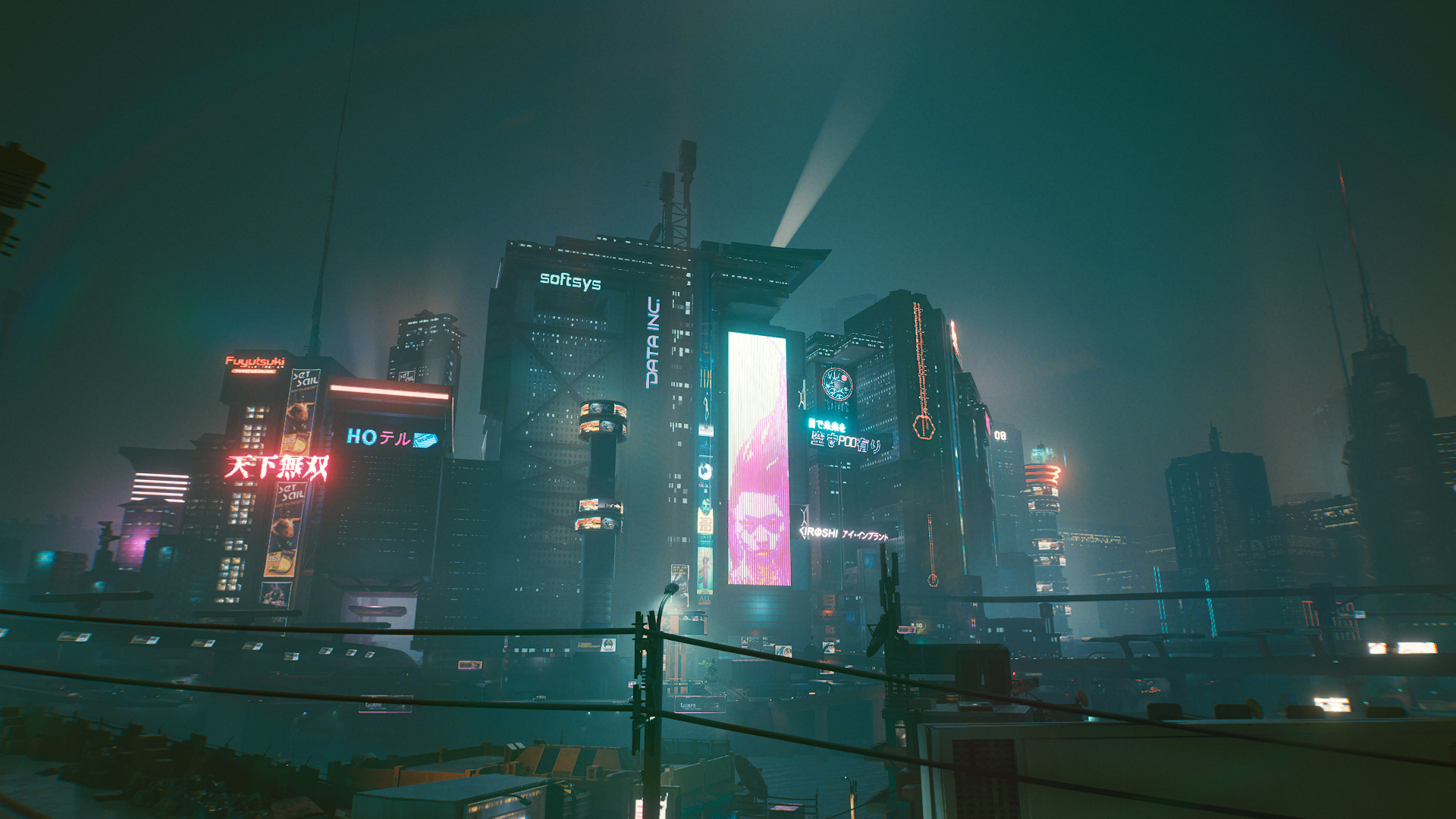
The Plot — It’s A Lot
Cyberpunk 2077 is a futuristic, first-person open-world roleplaying game, based on a tabletop RPG that first came out in 1988. It’s about a mercenary named V who, unlike the strong personality of The Witcher’s Geralt, is more of a canvas for the player to paint. Your appearance can be customised with a range of skin colours, hairstyles, and features. Rather than picking between “male” and “female,” you choose a traditionally male or female body type and choose between two penis types or one vagina. The pronoun characters use for you is either “he” or “she” based on your voice. While there’s more flexibility to this than we’ve seen in other games, tying binary pronouns to voice feels simplistic and retrograde. My V has a vagina and goes by “he,” but the game doesn’t seem to acknowledge that he’s a trans man; characters occasionally make reference to his dick or balls, though this could just as easily be metaphorical. In some scenes with hireable sex workers of different genders, I appeared to penetrate them — certainly possible, but with no indication that my character doesn’t have a biological dick. At one point a character made mention of the “mess” that is my V’s hormones, but I’m not sure if this is a reference to his body or something that would be said anyway.
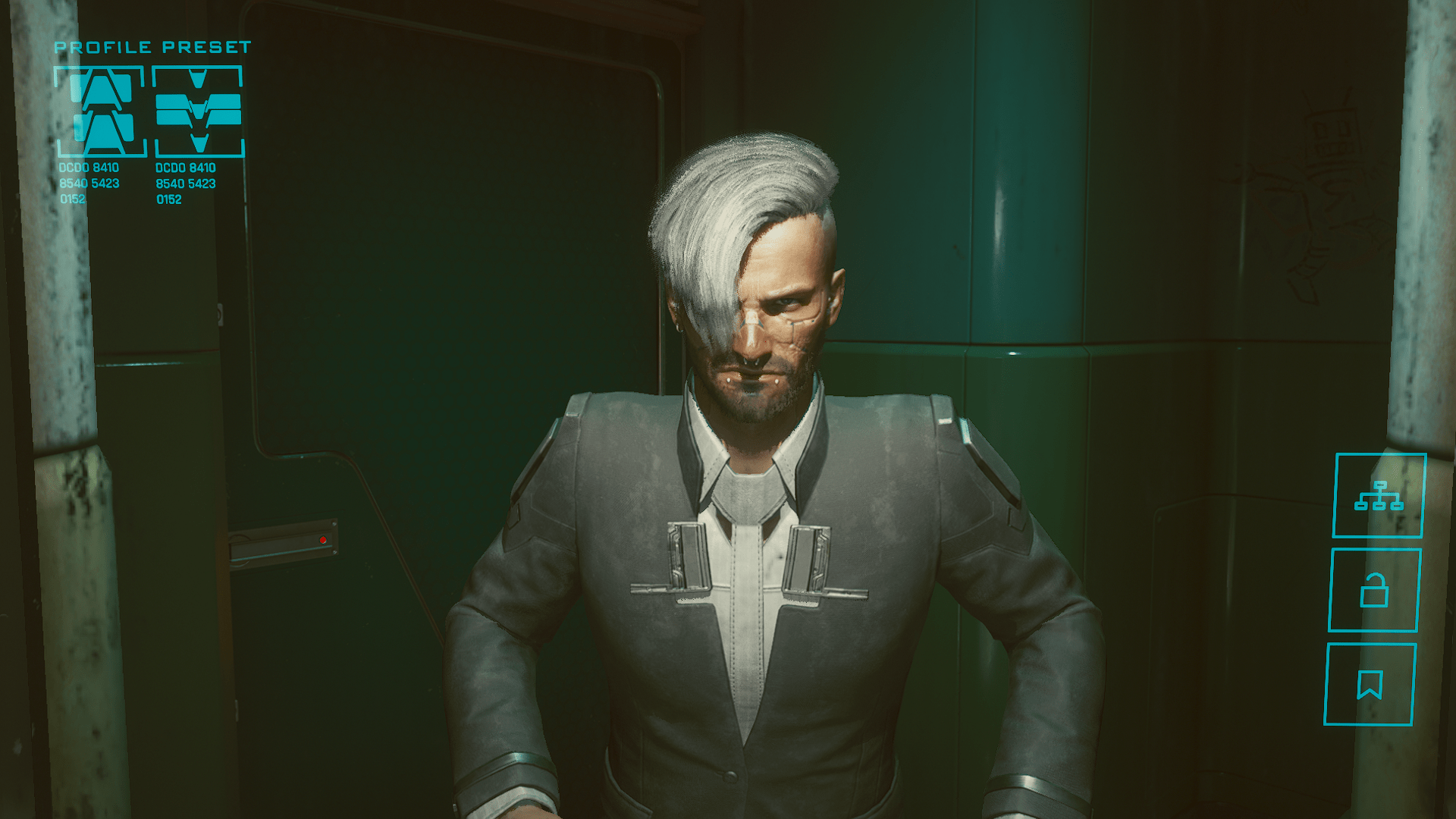
V lives in the California metropolis of Night City in the year 2077, when corporations have taken over the world and everyone has filled their bodies with cybernetic implants. How V gets there is dictated by one of your background choices; my V is a nomad, a smuggler who starts the game in the outskirts called the Badlands. That background gives me specific dialogue options throughout the game, such as commenting on the clan of nomads I left behind, or getting quest information from another nomad whose clothes I recognise. Whatever background you choose, a big heist goes wrong, and V finds himself in possession of a hot piece of technology: a biochip that promises a form of immortality. This gets him involved with Johnny Silverhand, a rock star-turned-terrorist who died decades ago and wants revenge. Silverhand looks just like Keanu Reeves, who voices him, and he talks in a way I can best describe as “Keanu Reeves is voice acting.” Keanu Reeves skulking into a scene to voice act can be distracting, but he can also be interesting and charming. To deal with all this, V makes friends and enemies with various Night City street gangs and power players, working as a gun/hacker/smuggler-for-hire for anyone who’ll pay or offer information, be that gangs, individuals, or the Night City Police Department. Main missions I’ve played so far have involved glitzy hacking heists in expensive locales, kidnappings requiring lots of explosions, and looking for information in a high-end, high-tech sex club. I’ve also used a technology called a Braindance that lets me experience people’s memories in first person, then zoom around inside them with a third-person camera to focus on audio, visual, and heat clues. It’s a sometimes clunky but compelling system that you’ll understand if you saw the 1995 movie Strange Days.

It’s all just so cyberpunk, a modern game in love with decades of books, movies, and anime about the nihilistic techno-future. From the jump, everyone talks in incomprehensible slang, the kind of thing I love to let wash over me when reading a William Gibson novel, but maddening as I struggled to parse conversations or find an item with a technobabble name that gave no clue as to what it was. The dialogue can sometimes be ridiculous: I cracked up when, in all seriousness, a character told me they would send me the “detes” about an emotionally-charged situation.
Many people in the world are afflicted with cyberpsychosis, a mental illness that affects some augmented people due to their implants, a tired trope we’ve seen in games such as Deus Ex: Human Revolution. The most powerful entities in Night City are mega-corporations that deal in technology, arms, and banking. Specific areas of the city are run by gangs; these characters traffic in fetishistic racial markers and stereotypes — the Tyger Claws wield katanas and control both Japantown and Little China, while the Valentinos make murals to Santa Muerte and control the Latino areas of the city. There are so many factions and companies that I struggled to keep track of them all as they mostly blurred together into “what language is the person shooting at me speaking?” In some missions I was given the option to doublecross powerful people I had just met, but I barely knew the world well enough to choose sides, much less the characters. The option felt like it was there mostly to give me some cyberpunk things to do.
Night City (which does in fact have day time, as well as changing weather) is over the top. What I’ve seen of the game takes place on one giant map, divided into districts, all with different visual themes: City Centre is full of corporate plazas and highrises, while Westbrook houses sex markets and pachinko parlors. These areas feel different, and they have their own specific gangs and key figures, but the whole world is huge and noisy and neon, and I often kept my eyes pinned to my mini-map while navigating to missions. While the flashing lights and colourful non-player characters give the feeling of a living city, it’s also a little empty. There are various commerce hubs where you can do things, but many of its bars, hotels, and shops are just window dressing. And while there are a lot of NPCs on the street, most of them just wander around and give short quips of dialogue when you knock into them. Night Ciy is also covered top to bottom in boobs, from advertisements to poledancers to sex clubs to — in an early story mission — an injured, naked woman in a bathtub of ice. The sexualization of the world feels juvenile. One important, interesting story scene included an incidental topless holographic dancer, her breasts undulating absurdly in and out of my field of view the entire time. There’s a black market traffic in sexual and snuff Braindances, because of course there is.
Story-wise, Cyberpunk is also a lot, with multi-quest main stories and an astonishing number of activities: meaty side quests from characters; gigs you can do for various agents called fixers; cyberpsychos to deal with as you please; map events you can do for the police, like stopping crimes and assaults; collectibles to search for; and people who need help. Your character has a cell phone; I get floods of calls as I drive around, and sometimes pivotal moments in a quest I was pursuing were interrupted by several NPCs calling and texting me one after another, urgently exhorting me to buy a car from them (you can just steal cars, but ones you buy or own can be called to you), come see them right away, or let me know there was crime nearby I could stop. I found myself feeling the same way I do when people at work won’t stop Slack messaging me when I’m in the bathroom. Mostly, this was just annoying; once, I missed a followup quest related to the woman in the bathtub that got lost in my quest log until I was at least 10 hours into the game. Its reward was an item that would’ve served me well, if only I hadn’t lost it in the rapid-fire arrival of available tasks.
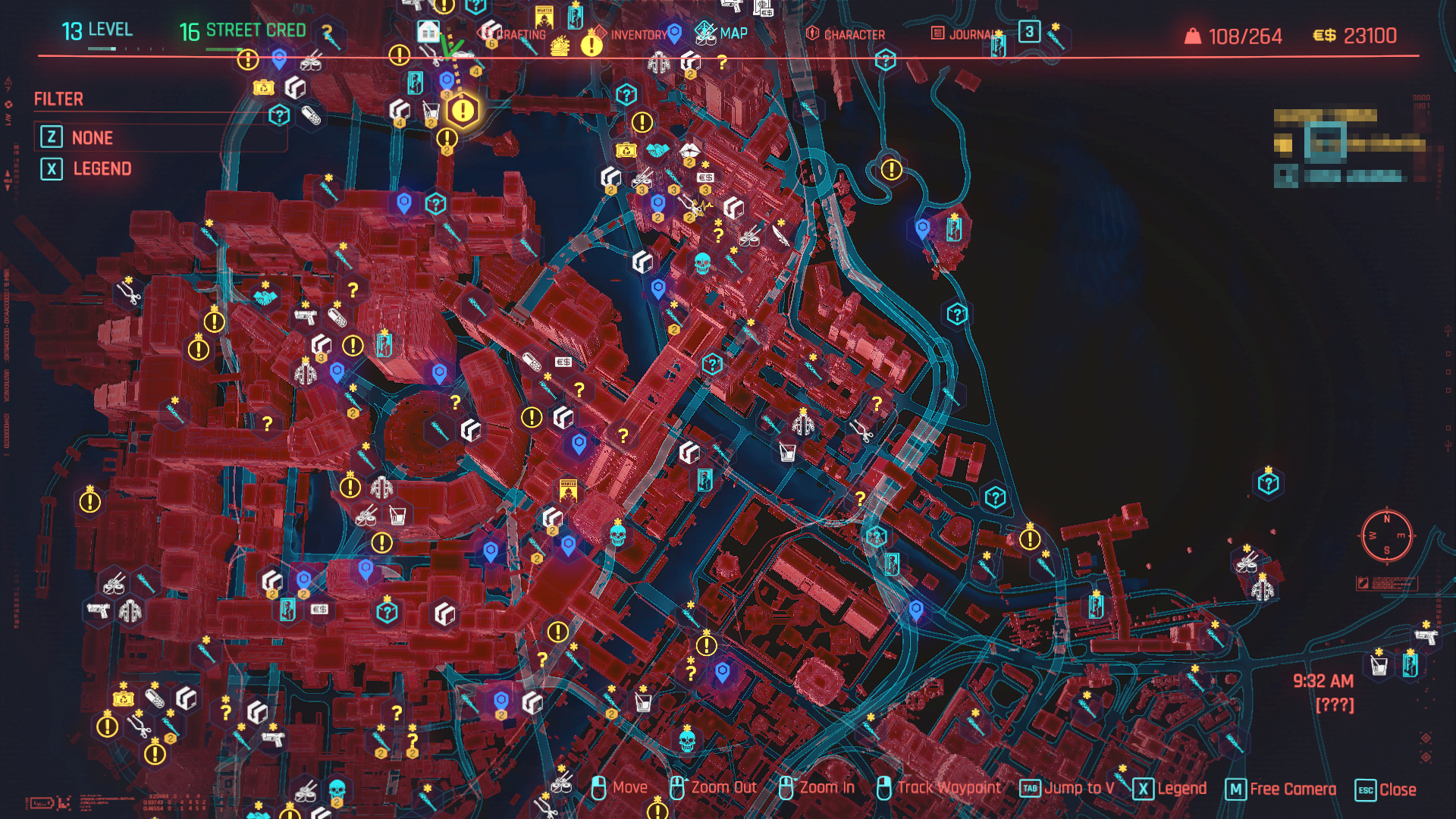
Verdict so far: Thirty hours in, I’m not that invested in the stakes of Cyberpunk’s main plot. There are so many corporations and characters and politics and backstory that are all, basically, excuses to get me to go to X cyberpunk place and do Y cyberpunk task. They’re the most fun when I stop trying to understand exactly what’s happening and just go with them, hacking, doublecrossing, and Braindancing as my mood and companions dictate. Main missions are multi-stepped and varied, featuring interesting characters and cool technology. Some story missions I’ve played have had very little combat, opting instead for hacking and sneaking that was ultimately on-rails but was still exciting. A few main missions went vastly different for me than my colleagues who are also playing based on our character builds, whom we chose to ally with, and what we chose to do.
Unlike The Witcher 3’s fleshed out, compelling sidequests, many of the minor activities that pop up on my map or into my journal are basic and forgettable, fights against human enemies that lack the visual interest or behavioural quirks of monsters in The Witcher 3. Still, they’re enjoyable enough, with flexible approaches and techno-cool that make them engaging, if not memorable.
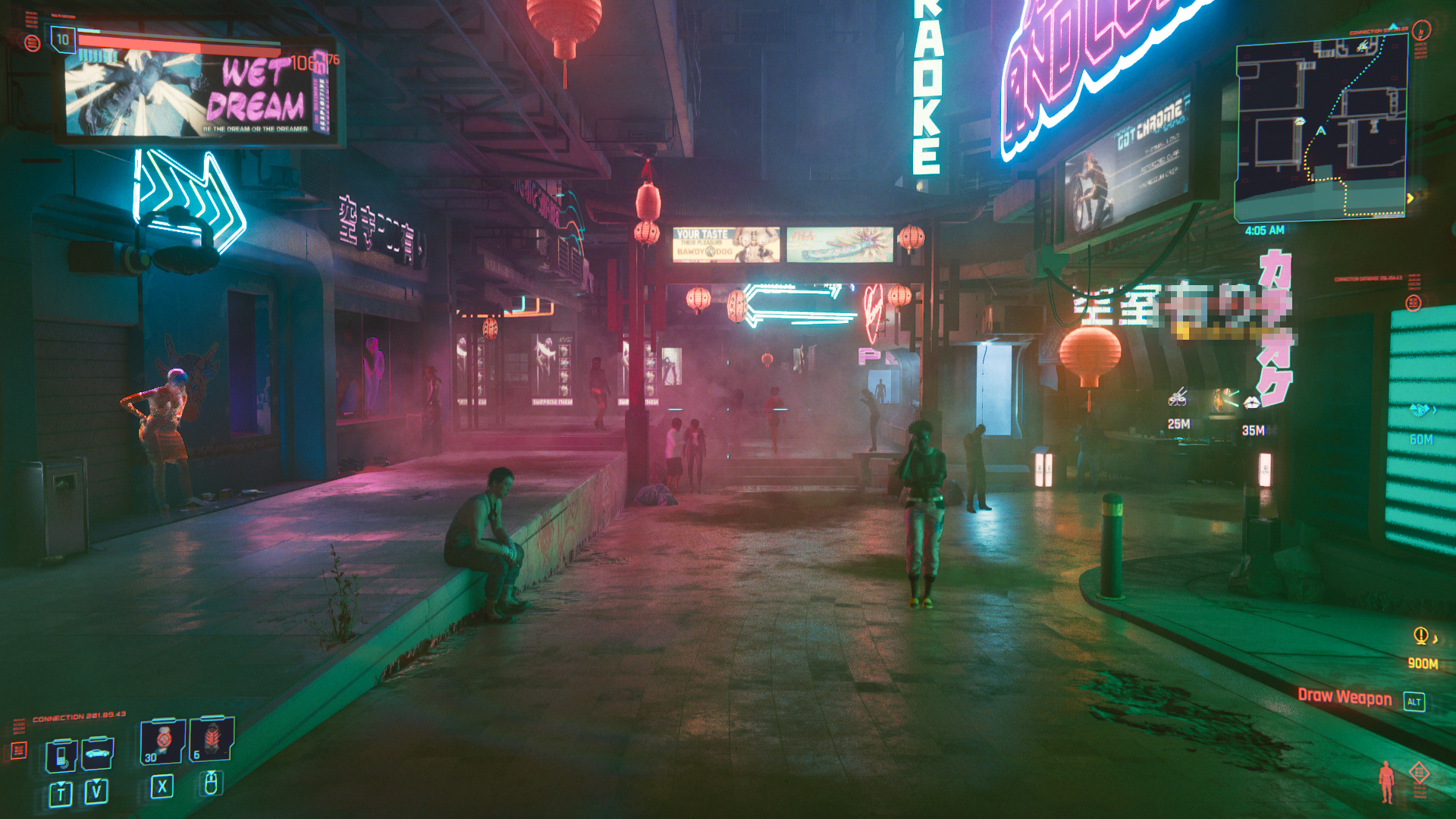
Systems — Complex, And Best When You Don’t Obsess Over Them
The game’s main systems are overwhelming. As you’d expect from a CDPR game based on a roleplaying game, Cyberpunk 2077’s character and levelling system is cumbersome. As my colleague Ian described in his preview over the summer, you have five main stats — body, intelligence, reflexes, technical, and cool (which dictates stealth) — each of which have various skill trees attached. The intelligence category, for example, dictates your hacking abilities, and its trees involve skills that let you turn enemy turrets friendly or do more damage with your hacks. You level up through playing — running around on foot instead of driving, for example, gives you XP in athletics under the body category. Levelling up athletics gives you increased stamina and carrying capacity. As you level, you also earn attribute points, which are put into your main stats, and perk points, which you use to unlock options in the skill trees. Some perks, as well as some actions you can perform in the world, are locked behind the stat of your base attribute — you’ll need level 20 cool to spend your perk points on the ability to guarantee a critical hit when you attack an enemy while sneaking. You’ll only be able to force open doors with a certain level of body, or hack certain terminals through a grid-based minigame with a high enough intelligence. Some weapons and equipment can only be used if your base stats are at a certain level, or if you have a certain perk. Basic XP flows pretty naturally, but I earned attribute and perk points slowly. My character currently has a total level of 16. I’ve cobbled it all together with a hefty amount of simply exploring, as well as completing a handful of gigs and over 30 side and main quests.
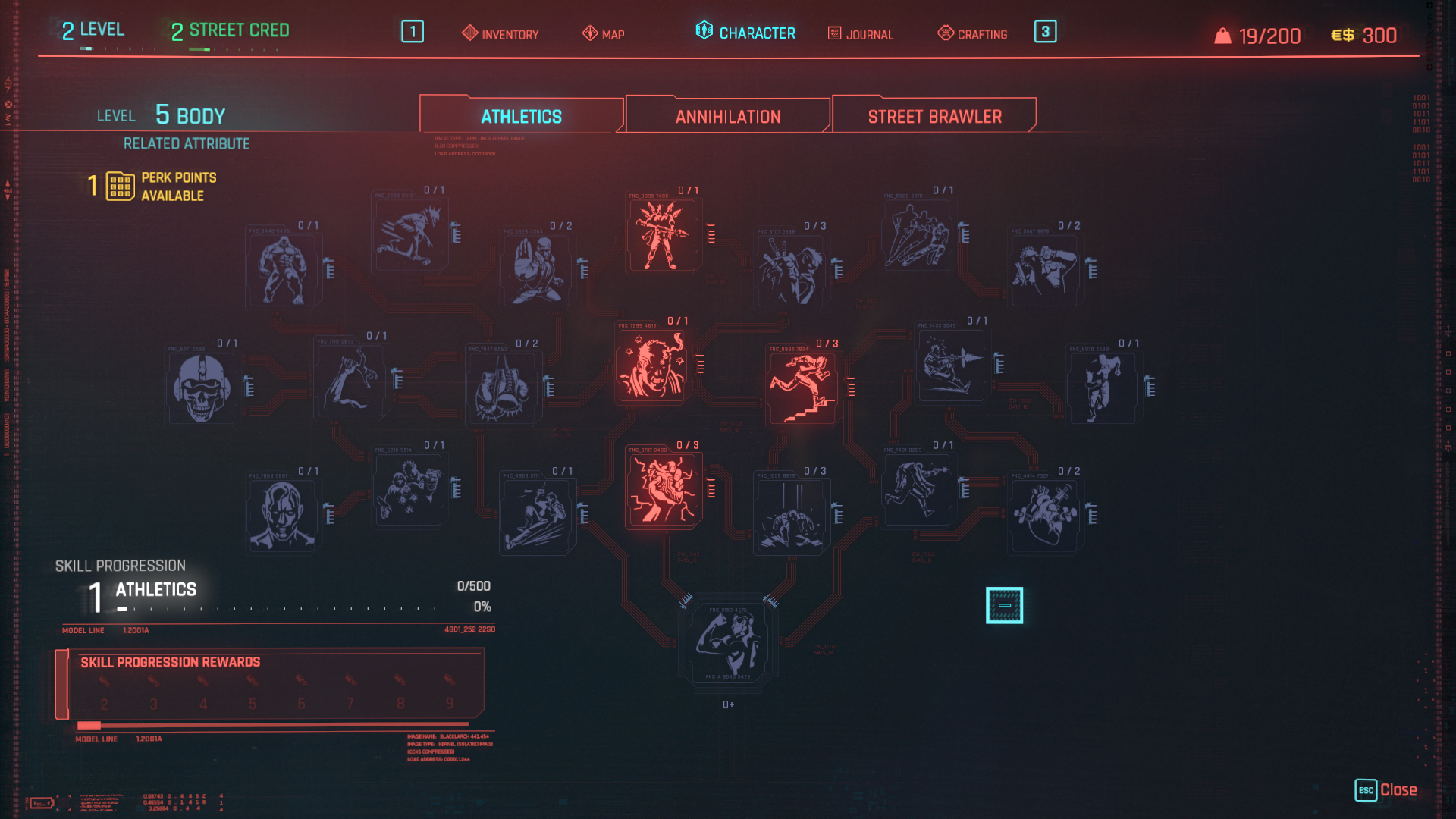
I’m currently at level 25 street cred, another system that runs alongside this. You raise street cred by completing gigs for Night City fixers. You need to raise your street cred to purchase certain weapons and clothing, which help a lot in main missions. (You can also craft gear with the requisite parts, blueprints, and perks that unlock higher-level crafting.) All this incentivized me to go off the beaten path, slowing down my story progress but compelling me to explore Night City. Gigs, missions, and hacking also earn you money, which you’ll need to buy this gear. You’ll also need money to buy body augmentations called cyberware and new abilities, called quickhacks, for your hacking implant, called a cyberdeck.
Initially, this was all bewildering. The multi-tiered system of attribute and perk points felt like putting a safe in a locked room, with the additional requirement of street cred being a key hidden in a fake rock somewhere on the grounds. I learned to enjoy these systems, counterintuitively, by deciding not to try to figure them out. Like Night City itself, I let the whole thing wash over me, giving up on planning a build and putting my points into whatever I needed at the time. When facing a mission with a gate I couldn’t open, I used an attribute point to raise my stats so I could. I’ve spent a lot of my perk points in the handgun tree in the reflexes attribute, simply because I found a pistol I like and use a lot. You’re not locked into any one tree or build (though there’s an expensive item you can buy that will let you entirely respec), so I’ve never felt like I’ve hamstrung myself with this willy-nilly approach. As I’ve earned myself better weapons, clothing, and equipment, what perks I don’t have feel like they matter less. There’s almost always some way I can make do with what I’ve got.
Approaching it this way not only slowly taught me the convoluted system, but made it fun. While the cyberdeck’s RAM and buffer and slots and quickhacks all felt like a bunch of irrelevant nonsense that could have been explained more simply, they offer an exciting range of possibilities now that I can afford them and see them in action. In one side mission where I had to sneak something past a hostile gang, I used one quickhack ability to reboot a character’s optics and sneak by, then a different quickhack to hijack a vending machine, lure enemies to it one by one, and take them out silently. I might not have the street cred to buy the best weapons or the cyberware to double-jump and shoot arm projectiles, but I can whittle down enemies with my sniper rifle, hack into the security system to open a door, then finish the stragglers off at close range with the homing shots of the “Smart” technology shotgun, using a cyberware implant I have.
Verdict so far: If you love menus and numbers, you’ll love what Cyberpunk has on offer. If you, like me, loathe these things, you can really just not worry about them too much. (By the time you play, you’ll also probably be able to avail yourself of the kinds of guides that were vital to me when parsing The Witcher 3’s mutagens, crafting, and skill trees.) There’s a lot of fun to be had if you make the game’s many systems your priority, but you can also just let the various trees do their thing in the moment.
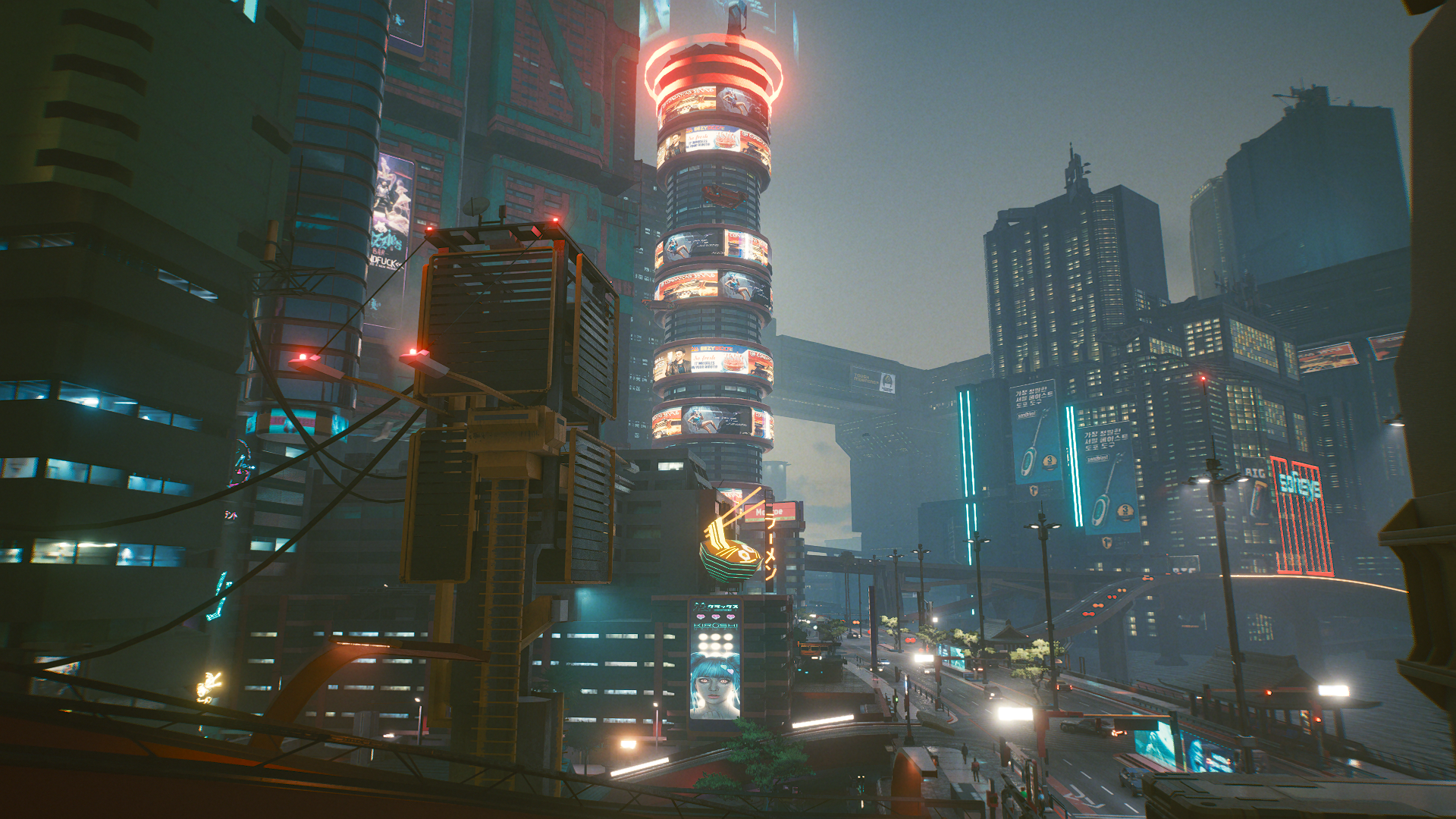
Combat and Gameplay — Messy, But It Works
Cyberpunk is neither a great shooter nor a great stealth game, but I’m ok with that. Enemies take a lot of hits to put down, and in combat they tend to hang back or race from side to side with few interesting tactics. This can make the AI seem unintelligent, but it also lets me chip away at their health bars fairly safely, while giving me the breathing room to switch weapons, suck down health and stat-boosting items, and employ my quickhacks. Different guns have different situational skills; I don’t currently have any Tech weapons that let me fire through cover, but my Smart weapons can hone in on enemies once I have them in view, and my Power weapons can bounce bullets around. Fights can feel more like a lengthy war of attrition than a high-octane battle, which might change as I get new weapons and abilities. For now, I like the somewhat slow pace.
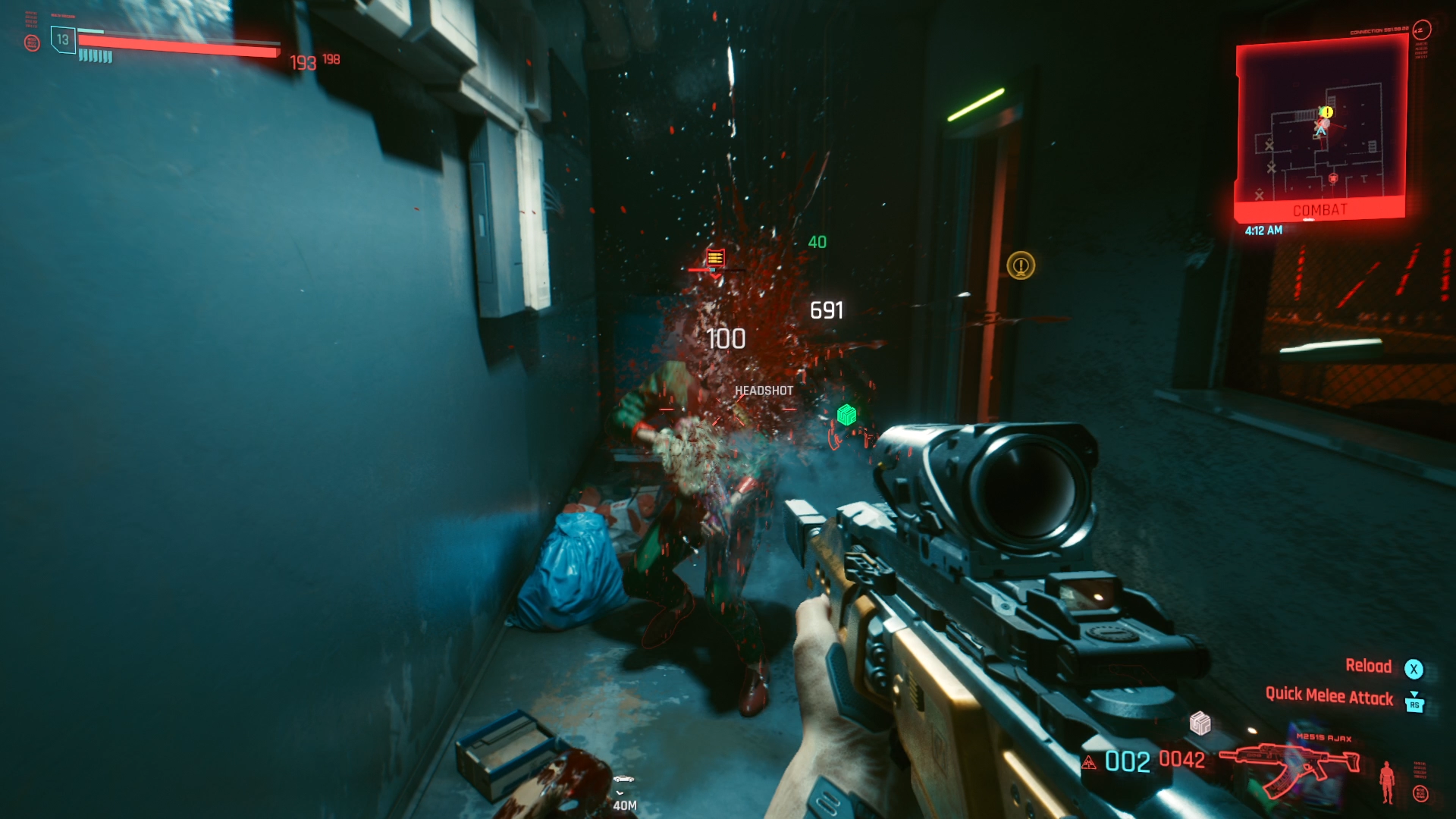
Stealth is viable but not robust; I rarely managed to stealth an entire mission. As Ian found in his preview, it can be hard to tell if I’m fully in cover, often getting me spotted. Though time slows when you switch to your hacking mode and hover over enemies to see your quickhack options, enemies would notice me if I took too long. While the stealth gameplay and hacking options look a lot like my beloved Deus Ex, I haven’t found myself able to play the way I would in those games. Stealth has been more useful to me in the prep phase of missions: I can hack into a camera to hop through an area’s surveillance network, opening doors and disabling turrets, then pick through an area’s enemies doing non-lethal takedowns and hiding a few bodies before I’m inevitably spotted and a shootout ensues.
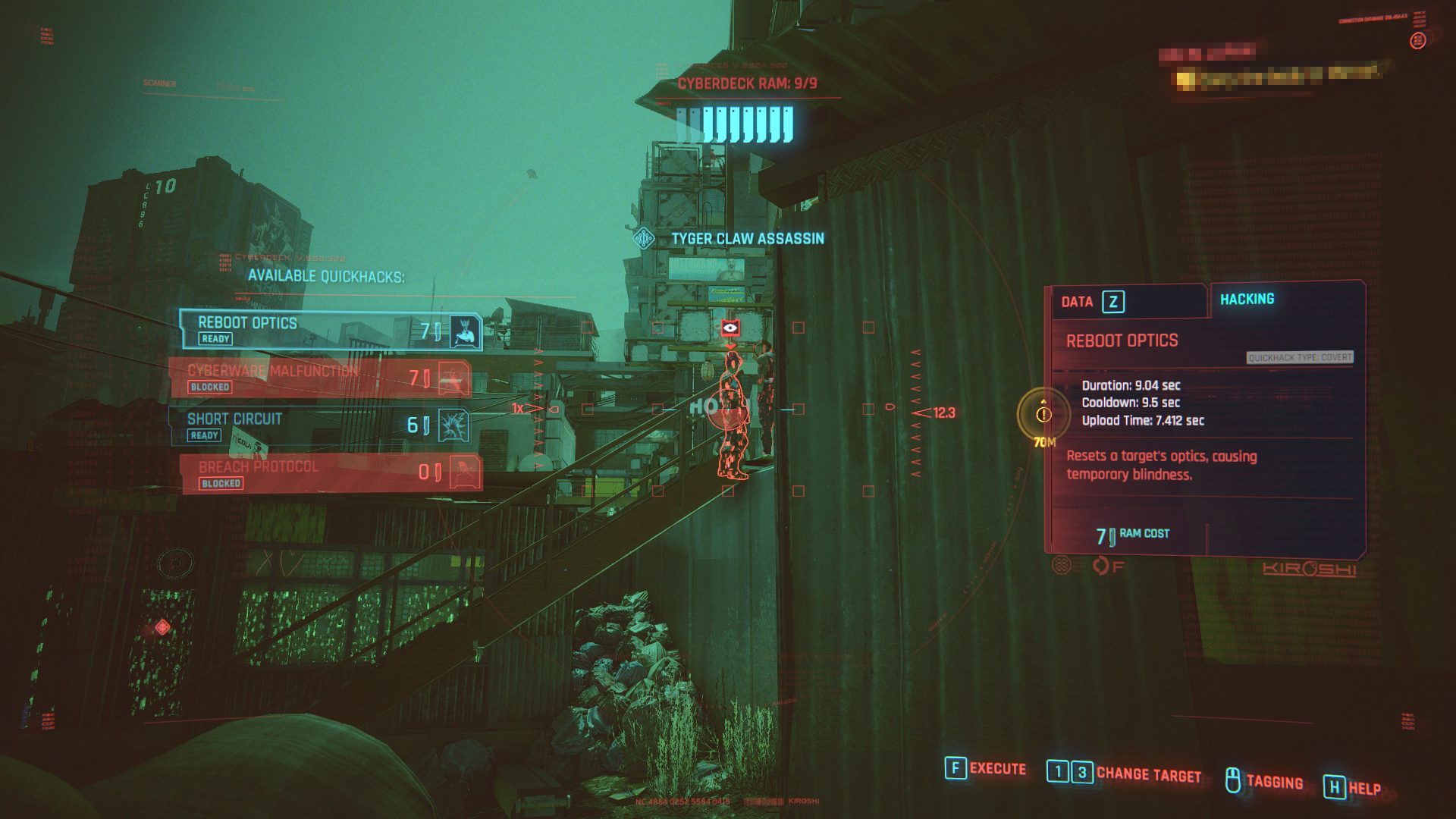
Some missions don’t involve much combat at all. Sometimes they’ll be about parsing through Braindances for clues. Other times they’ll be more about hacking. A series of side missions I picked up involves chasing down self-driving cars. (The driving, a main feature of a game awash in unique rides, can be maddening; vehicles are difficult to control with keyboard and mouse, though my colleagues say they’re slightly better with a controller. In one side mission, I got a motorcycle through moving, personal circumstances, only to immediately ruin the moment by losing control of the overly-sensitive bike, smashing through several pedestrians, and getting the cops on my tail.)
Verdict so far: I’ve mixed and matched stealth, hacking, and pure combat in most missions I’ve played, from main story to side missions. None of these systems are standout, but they work together to create something that’s messy and chaotic, but ultimately enjoyable.
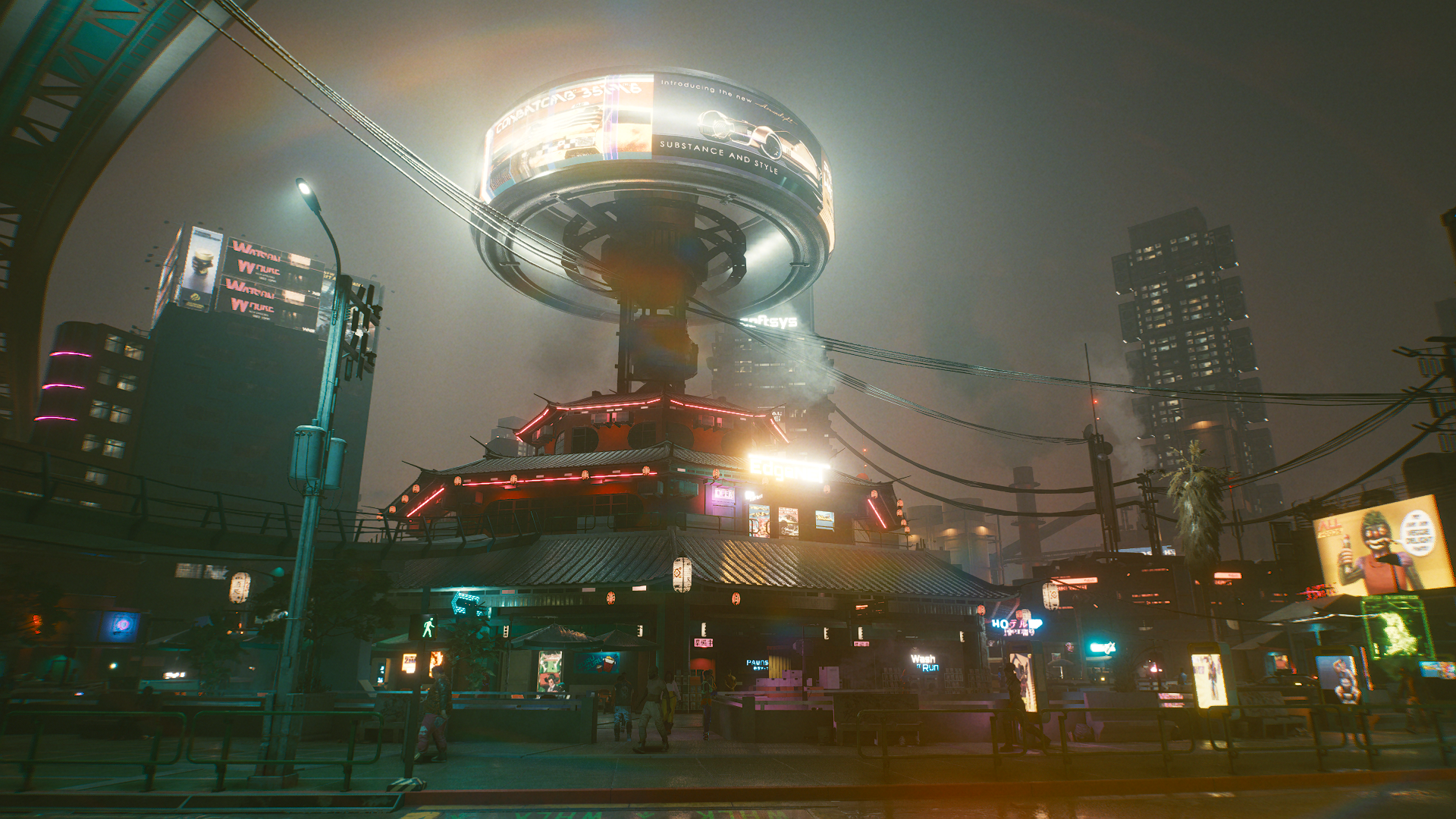
The Game’s Diversity — Some Surprises, But Not That Deep
Cyberpunk’s racial, gender, and sexual diversity have been complicated topics in all the game’s pre-release leadup. It’s a relief not to be in the all-white world of The Witcher 3, and there’s a realistic range of languages, body types, skin colours, gender presentations, and sexualities. The snippets of all this that we saw pre-release made many potential players, myself included, anxious about how these identities would be deployed in the game. Much of it seemed offensive or trope-y, the surface appearance of diversity without much thought or sensitivity behind it. As a white, queer trans man, I can only speak to some of the portrayals from my experience, and there’s plenty of the game I haven’t seen yet. But so far, all the game’s representation, the kinds of things many of us rightly demand from video games, feels employed more for colour in the game’s futuristic world, or because it’s been used in cyberpunk media before. The world is heavily influenced by Japanese culture, because cyberpunk works do that. There are queer people because everyone in the game’s world indulges their sexual desires to their fullest. There are trans people because everyone’s modifying their bodies in all kinds of ways. The world’s diversity doesn’t feel forced, but race, queerness, or transness don’t feel like topics the developers are interested in specifically addressing or exploring. Similar to how I felt about The Last of Us 2, Cyberpunk’s diversity is more visible than we’ve seen in many big-budget games before, but it doesn’t feel like it matters.
As for race and ethnicity, I haven’t yet seen every depiction in the game. For instance, I haven’t yet encountered much of the Voodoo Boys gang, whose roots in the tabletop game involve white people culturally appropriating Haitian culture. In the video game, they appear, from what I’ve seen, to be Haitian. But the centrality of the various gangs’ identities around race opens the door for simplistic, trope-laden portrayals. This, alongside the many East Asian influences the game draws on, means the world is actually admirably multi-lingual; subtitles translate into your chosen language in real time, which is cool, even if the text flickering between languages can sometimes be hard to read. But some Japanese characters speak in awkward proverbs. One clothing vendor spoke in stilted tones about sakura blossoms; V has the option to confront her by saying Japanese people don’t really talk this way, and she relents, admitting she does it to con tourists. It’s a moment that skirts close to acknowledging the cyberpunk genre’s fetishization of East Asian cultures, but it’s fleeting. From what I’ve seen so far, Cyberpunk seems content to use race mainly to give groups visual or linguistic markings, without considering these identities very deeply. I look forward to other writers exploring these portrayals in depth.
I can speak best to Cyberpunk’s already controversial use of trans people. As seen in pre-release information, a lot of trans content is consigned to in-game ads, such as the soft drink ad featuring a female-appearing character with a giant cock bulging from her leotard. The game has yet to indicate if there are any other trans men in the world besides my version of V; I suspect I’m the only one, and I’m torn between relief and hoping to be proven wrong. I have encountered at least one other trans character: at one point I happened upon a dressing room conversation between a woman who identified herself as cis and a character who had a traditionally male appearance but a feminine voice, who bemoaned theatrically, “I’m a woman; that demands sacrifice.” Her companion replied, “See, I’ve always been a woman,” angering the trans character. “Oh, so this is what fucking sororal solidarity looks like now?” she snapped. Her companion replied, “Welcome to real life, sister.” As a trans person, this was a complicated, weird moment to overhear. The conversation comes after a key story scene, in an area you have to pass through to continue the quest; you could easily walk by it, but it’s hard to miss. I’m not sure why the developers seemed to want me to see it. On the one hand, I’ve heard versions of this conversation play out between cis and trans women in my real life, and had versions of it myself as a trans man with cis men. On the other hand, I could easily see the trans character’s appearance and voice being played for laughs. Of course, there was no option to rush up to the trans woman and say “I’m trans, too!” Both characters fell silent and didn’t have any more dialogue.
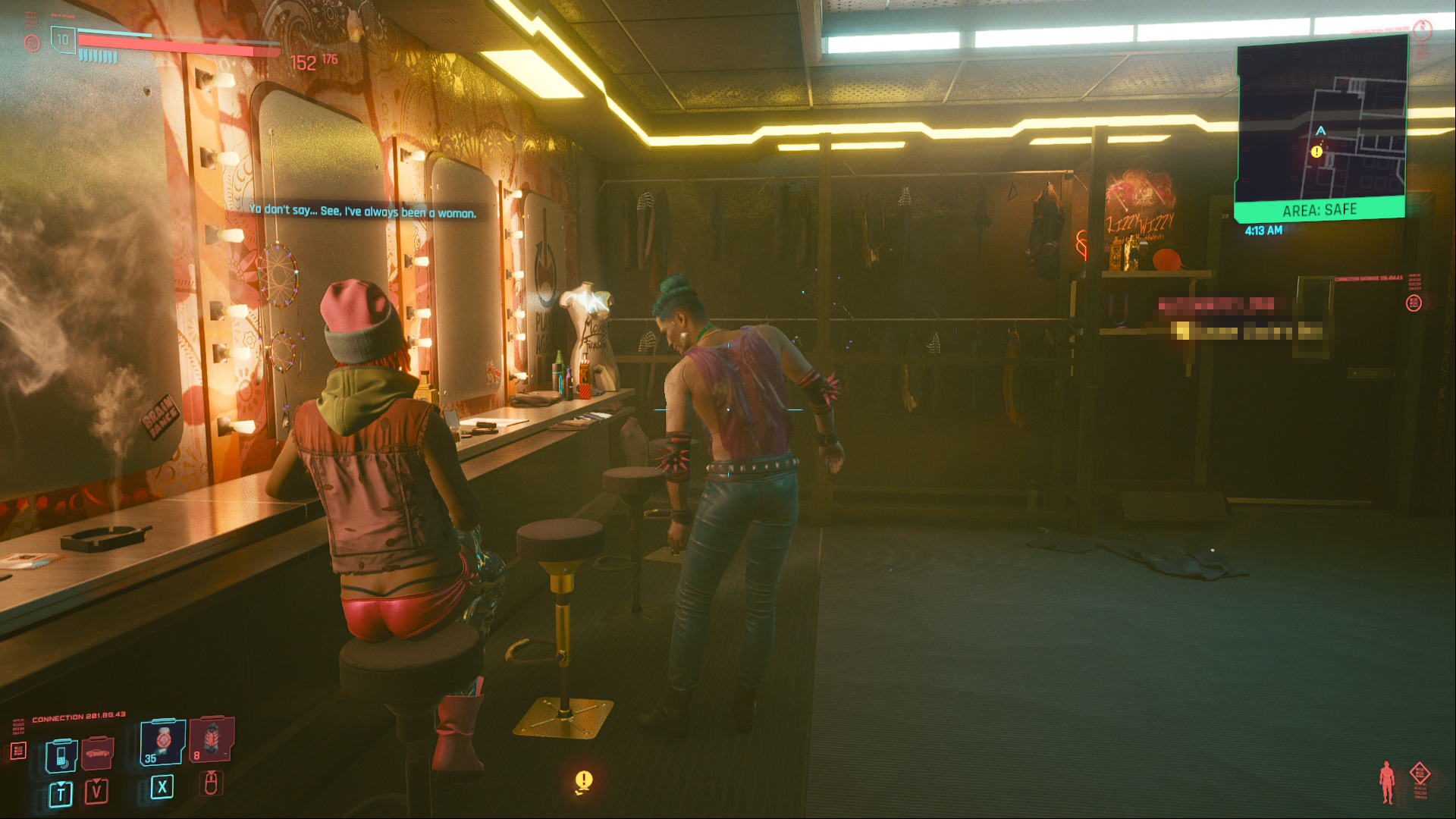
Another pre-release controversy involved an ad for an in-game TV show called Watson Whore, in which a feminine-appearing person pukes over a toilet, with a dick visible through their tight underwear. In-game, a TV ad for the show used “he” to refer to the character, which surprised me when I overheard it. I found a diary for the Watson Whore that talks about wearing dresses while also discussing showing off for someone because “I could tell he loves pretty boys.” That same diary also mentions that the Watson Whore “made a move on town hall to protest the fuckin disgraceful neglect of war vets…chanted my fuckin throat raw half the way down there.” Like the dressing room conversation, I was torn: the thought of a gender-creative sex worker going to protests was exciting, but the seeming mismatch between the Watson Whore’s appearance and identity made me suspicious. I don’t know what CDPR’s intention with the character was; it doesn’t feel like a celebration of diversity given the studio’s track record, but for all I know it could be. All of this has just been side content, at least so far.
Verdict so far: While Cyberpunk draws on diversity, it doesn’t really do anything with that, in ways that are disappointing if you hoped for more, or anger-inducing if you’re sick of watching people who don’t share your identity use it as a trope or gimmick. Diversity of all kinds feels like it’s in Cyberpunk because it got caught in the tide of stuff CDPR wanted to put inside the game. Personally, the trans content I’ve seen so far didn’t deeply offend me, but that’s my own stomach for such things. But I’m not necessarily interested in knowing what a game studio thinks about my existence; I don’t need Cyberpunk — or any game — to tell me about myself. Still, I don’t think I’m alone in wishing the game were doing better with the identities it portrays, and I understand anyone who feels like they just don’t have the energy for this shit.
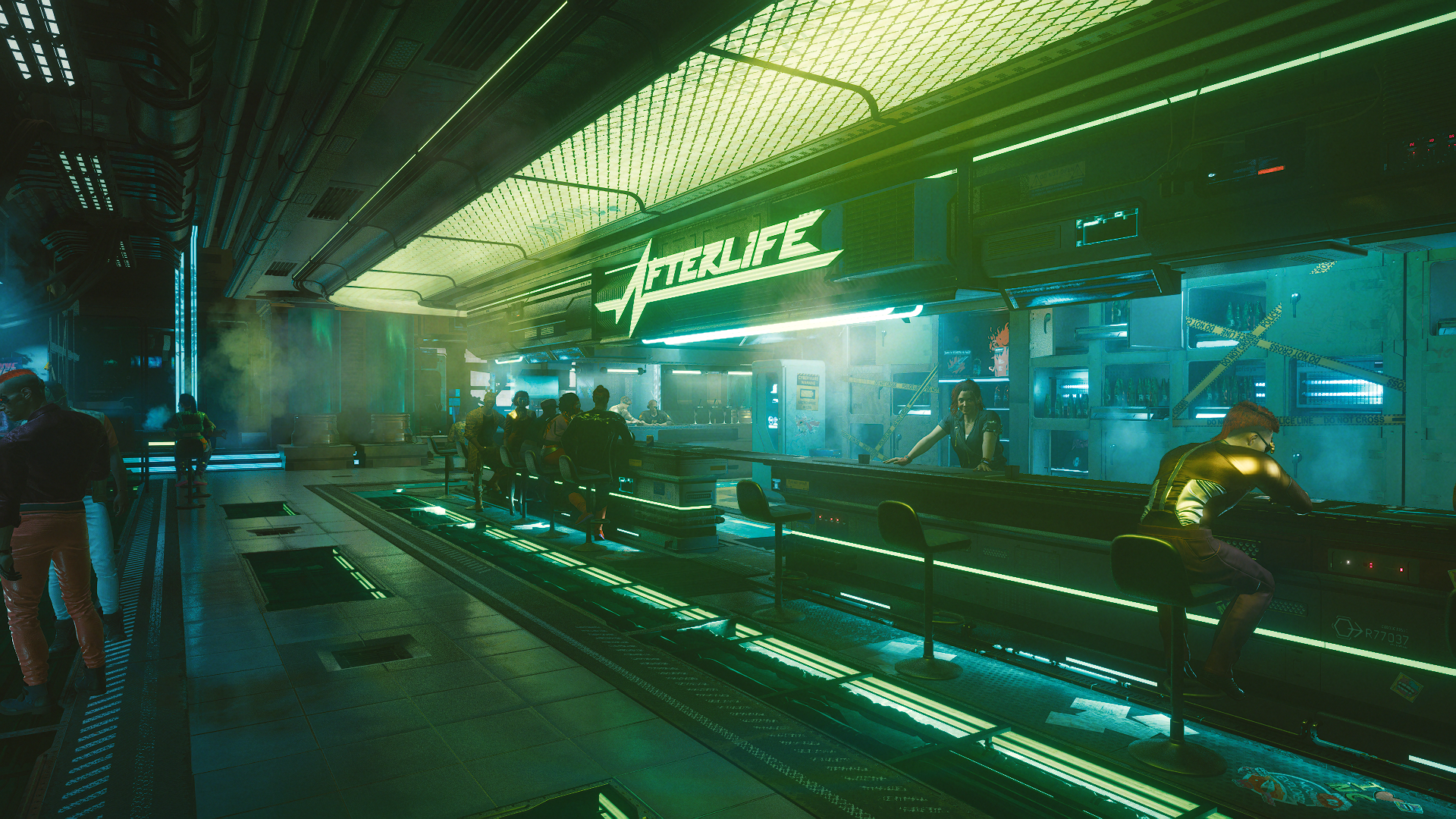
The World — Nothing Beats A Lore Book
The Witcher 3 explored themes of what it means to be human and how we care for each other in the face of evil. That evil could be seen spreading across the land through human war, as well as the superstition and hatred the Conjunction of the Spheres brought in through monsters and clashing fantasy races. Even when The Witcher’s fantasy jargon turned me off, I empathized with the people struggling to survive on The Continent, and it made me think about my own life in new ways.
But it’s hard to understand why people live the way they do in Cyberpunk, what motivates them besides the surface level concerns of money and status. Lore books and news broadcasts flesh out in detail how the world got to be the way it is. They’re easily missable, but they also feel vital for understanding things that happen in the plot. A ton of work has clearly gone into them, and they’re a joy to read. Through them, the game touches on topical issues like environmental collapse, celebrity, union-busting, the unaffordability of health care, bioengineered food and synthetic meat (one book opines, “it’s hard to imagine now — a world where things used to grow out of the ground without our help”), religion, the effects of the internet, viruses and pandemics, and colonising space. These ideas filter into the world through advertisements for water and cybernetic upgrades to do well at your new job, through anti-homeless spikes on all the benches and veterans begging for change, through conversations about the cyberpsychosis and PTSD so many people seem to suffer from, through sidequests about corrupt politicians and police forces closing ranks. As one email I found reads, “Night City’s a fucking dystopian cesspool…The 20th century’s worst fever-dream nightmares have come true before our very eyes.”
But Cyberpunk so far has nothing to say about how humanity made those fever dreams a reality. It can be traced historically through the game’s abundant lore, but the lived experience of it hasn’t felt real to me. The game isn’t some kind of warning about the future; it seems to take as a given that the world will descend into a money-obsessed techno-dystopia, with how people let things get this way a lesser concern than how they can make a living in their reality. People hate corporations, but also worship them and want to be part of them. Johnny Silverhand rails against them at one point, but the scene felt like it was trying to convince me rather than giving me room to share those views. An in-game radio host told me that people in Night City “either die on the job or die of hunger,” before summing it up as “First world problems, am I right?” In one sidequest, I rescued a character from a gang that wanted to force them to get technological implants. At the most basic level, this made no sense: performing medical procedures on a rando is certainly a complicated, expensive way to screw with them in a world where most people seem to live in poverty, despite, as one book told me, an 80 hour work week being considered a good option for people with families. It made me wonder how everyone has the time, energy, and money to parktake of the world’s prodigious sex trade.
Cyberpunk draws on the trappings of so many vital issues in today’s world, but it doesn’t engage with them deeply. They’re colour, ultimately. Even in main quest scenes where I’ve gone head to head against powerful figures, I didn’t come away with some new understanding about capitalism, technology, power, or violence. As with the game’s diversity, these big issues are hugely present in the game, but it isn’t really about them.
Verdict so far: In a deeply 2020 way, I’m both disappointed and relieved by this. Right now, I don’t need a game that really wants to make me feel the sting of rich and powerful politicians leaving me to die when the going gets tough, instead of just mentioning that they have through lore. It might be a missed opportunity to use the game’s main story to say big things, but I’ve also enjoyed exploring it at my own pace, learning about the game’s politics and history by digging into the crevices of its map rather than having the story tell me what to think of them. All this might change as the game goes on, but right now I think I’d be just as happy to let it stay in the background.
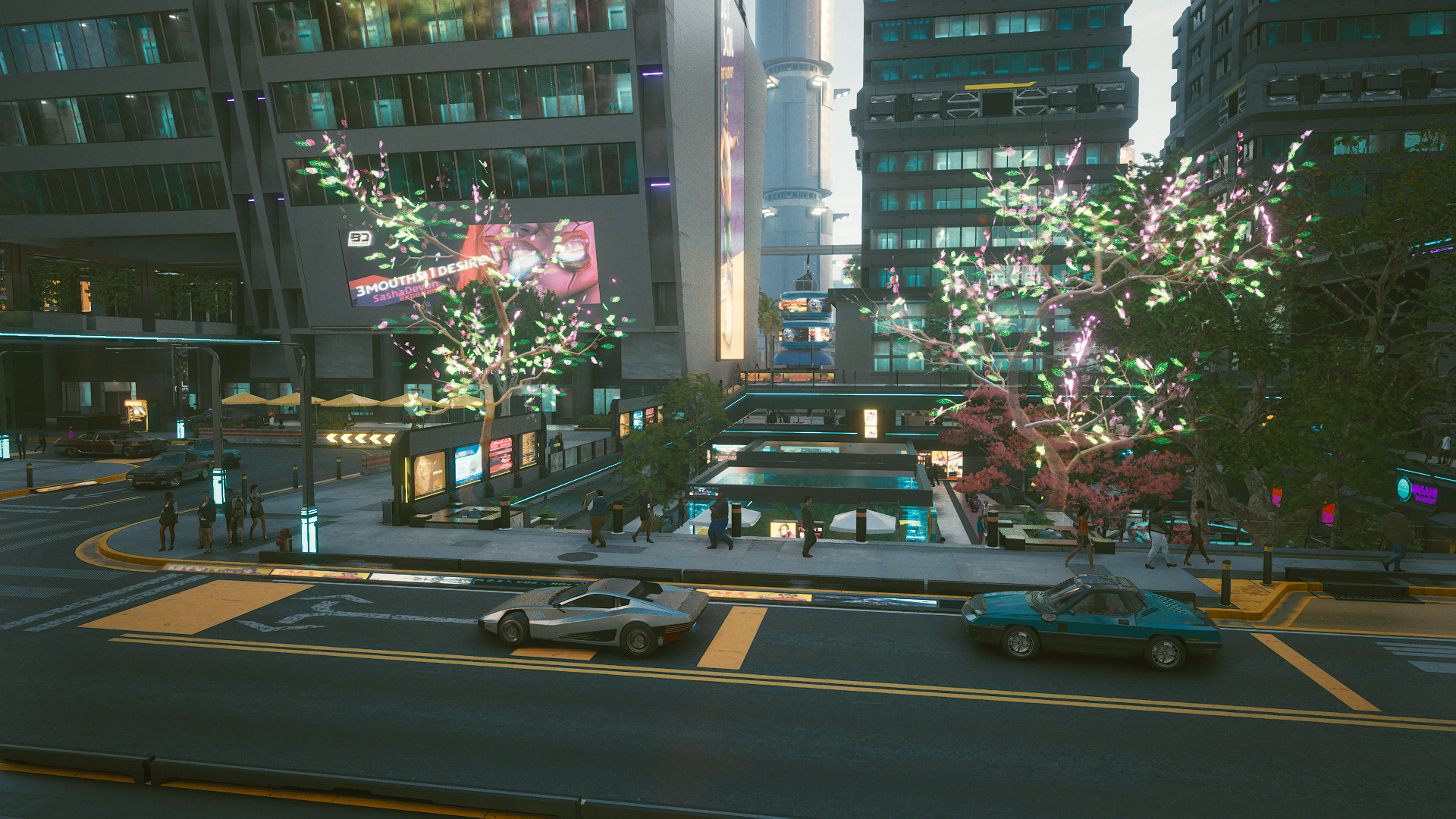
My Overall Verdict So Far
So far, as much as I wanted it to be, Cyberpunk 2077 isn’t The Witcher but in the future. I haven’t yet found the heart of the game, that core that would make me want to curl up and live in it like I do The Witcher 3. Few quests have moved me the way that game did. I don’t enjoy being V the way I enjoyed being Geralt. Even the most eye-catching futuristic vistas haven’t irresistibly called me to see if I can get to them. I’ve enjoyed some characters, but they haven’t been as relatable as The Witcher’s. There’s been no game-changing Bloody Baron quest, at least yet — missions have been exciting and deliciously cyberpunk-y, but nothing that’s rocked me emotionally.
But there are hints of something here, surely motivated by my love for The Witcher as well as what’s in the game itself. I couldn’t sense it when I stuck to the story, but I started to find snippets of it when I let that story fade into the background. There was a sidequest that was personal and moving, at the end of which I thought I was making the right choice but actually made the complete wrong one. (I reloaded; can’t fool me again, CDPR game!) In another, I had to decide the results of an investigation that I suspect will have political ramifications for Night City, and I felt the full weight of the responsibility on me as characters waited expectantly for my dialogue choice. I awkwardly hit on a character after a dramatic, involved quest; she rebuffed me, but I hope I get to try again. One in-game and real-life night, I took V back to his apartment to go to bed before going to bed myself, only to get sucked into a real-world half-hour of watching news and commercials on V’s TV, marvelling at the world-building and details as much as the welcome mind-numbing effect of zoning out in front of the TV. Wandering Night City’s business district, I found a tree that wasn’t a hologram like so many others in the game, encased in a glass plaza complete with piped-in birdsong, which I wouldn’t have noticed if I hadn’t read a lore book that informed me that all birds in Night City have been killed. I spent a long time just standing around in this peaceful, easily-missed oasis. There’s a wonderful sense of possibility as I zoom over the game’s bridges on my difficult-to-steer motorcycle, the radio pounding and the neon lights welcoming me. The game lets me be a sober trans guy.
Separated from its marketing, hype, and expectations, so far Cyberpunk 2077 just feels like a huge, scope-ambitious video game, with tons of attention paid to its lore and scenery and lots of dramatic things to do. It’s not the best game I’ve ever played, as so many fans seem to hope it will be. Despite the controversy that’s swirled around it and its own missteps, it hasn’t yet inspired me to immediately consign it to the trash heap of retrograde video game shit. In many ways, it feels like it’s about itself — its genre and source materials, the work that went into it, the flexibility it wants to give the player — from its character creator to its in-the-moment play. Saying “it’s just a video game” doesn’t quite explain what I find compelling about it, nor what I find complicated. But after all the hype, and despite a certain disappointment of my own hopes, I’m also relieved to find that it’s just a video game. I’m ready to escape the years of being told what Cyberpunk is and find out what it is for myself, as I imagine many of you reading are too. We’ll see what it turns out to be for me, and I’m curious to find out what it turns out to be for you.
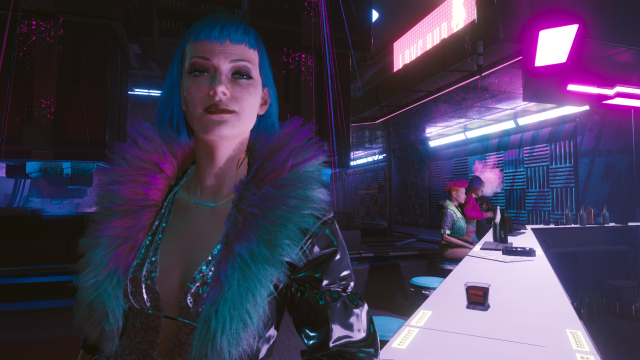
Leave a Reply